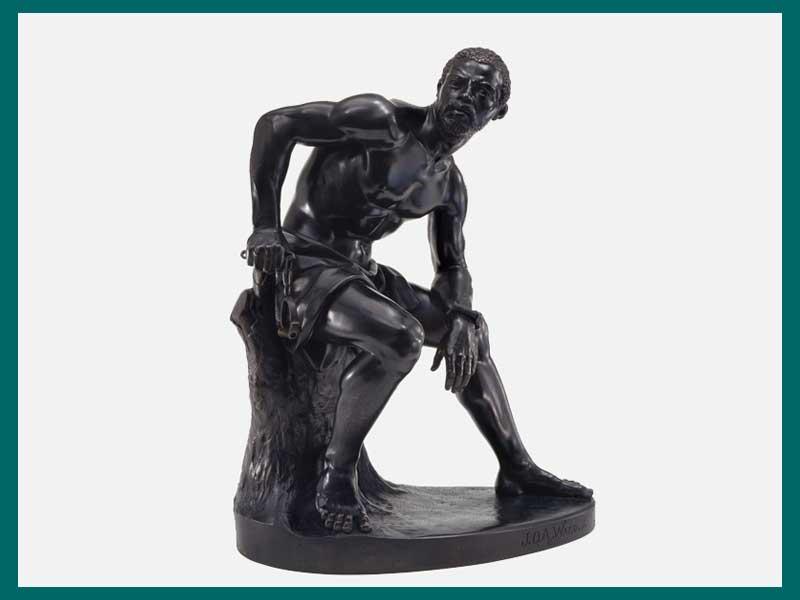Newcomb Art Museum marks the 160th anniversary of the Emancipation Proclamation in its fall exhibition
In conjunction with the 160th anniversary of the Emancipation Proclamation, Newcomb Art Museum at Tulane University presents newly commissioned and recent works by living Black artists. Seven living artists represented in the exhibition Emancipation: The Unfinished Project of Liberation were each invited to respond to John Quincy Adams Ward’s bronze sculpture The Freedman (1863) owned by the Amon Carter Museum. Artists Sadie Barnette, Alfred Conteh, Maya Freelon, Hugh Hayden, Letitia Huckaby, Jeffrey Meris, and Sable Elyse Smith offer us their visualizations of Black freedom, agency, and the fractured legacy of the Civil War today in sculpture, photography, paper, and textile fabrication. The show will be on view at Newcomb Art Museum of Tulane University from Aug. 17 through Dec. 8, 2023, before traveling to Williams College Museum of Art (WCMA) in Williamstown, Massachusetts, and Telfair Museums in Savannah, Georgia.
Seeking a deeper understanding of what freedom looks like for Americans after 160 years, Emancipation interrogates the role of sculpture in American life. Ward’s figure in The Freedman is depicted on the cusp of liberation with bonds ruptured, but not removed. The work is one of the first American depictions of a Black figure cast in bronze. While considered aspirational in its time, over a century and a half later, The Freedman’s resonances of uncertainty and endurance elicit considerations of slavery’s still unresolved effects today. Including works on loan from leading national museums, this exhibit offers a continuing conversation about freedom, imprisonment, corporality, personhood, and power in America today.
Newcomb Art Museum will also highlight works from its permanent collection to draw attention to the distinctive history of enslavement in New Orleans and Louisiana. The works of Angela Gregory, Carrie Mae Weems, Ellsworth Woodward, and William Woodward exemplify the museum’s commitment to foreground the significance of gender, paying tribute to the creative legacy of Newcomb College as the first coordinate college for women in the United States, and presenting art that encourages critical civic dialogue and community transformation. “This exhibition is timely since Americans are reckoning with history and how to interpret the impact and after-effects of slavery,” said Maurita Poole, executive director of Newcomb Art Museum and co-curator of Emancipation. “The contemporary art breathes new life into the notion of emancipation and hopefully will encourage audiences to reconsider their perspectives about freedom and full citizenship in the United States.”
“As a curator, I’m tasked with unlocking the multiple meanings artworks accumulate over their lifetimes, but I hold the firm belief that historical works find their true potential in the hands of contemporary artists,” said Maggie Adler, curator of paintings, sculpture, and works on paper at the Carter. “The Carter is committed to fostering the efforts of living artists whose work resonates with history, and Emancipation is a case study in the new creative possibilities that can be realized by seeking inspiration from historical collections.”
The exhibition will be presented with a companion book, co-published with the University of California Press, featuring Q&As with the exhibition’s seven contemporary artists and essays by Kelvin L. Parnell Jr. (PhD candidate, University of Virginia, Department of Arts and Sciences); Kirsten Pai Buick (professor, art history, University of New Mexico); Andrew J. Walker (executive director, Amon Carter Museum of American Art); Thayer Tolles (Marica F. Vilcek (curator of American Painting and Sculpture, Metropolitan Museum of Art); and the co-curators, Maggie Adler and Maurita N. Poole. The book will also include a short story by N. K. Jemisin (Hugo Award-winning Black science fiction/fantasy writer).
Funding for this project included generous contributions from Sasha and Edward P. Bass, Katherine Steinmayer McLean Newcomb Art Museum Fund, Ruth Dermody Sterling Fund, Elise Levy Steiner Fund, and NAM’s annual exhibition funds. Exhibit programming is supported by Dorothy Beckemeyer Skau Art and Music Fund and the Sandra Garrard Memorial Fund.

